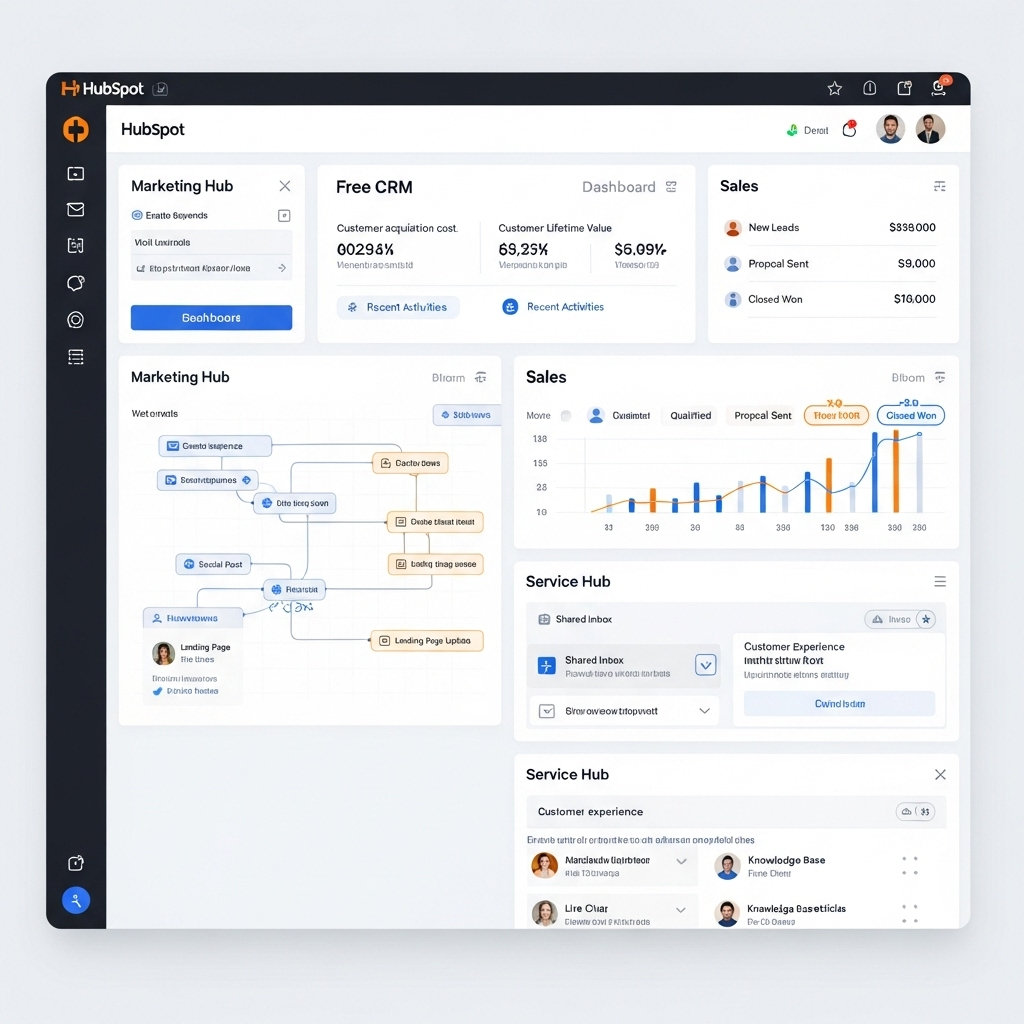
Table of Contents
While my analyses often focus on enterprise-grade systems like Salesforce or Adobe Marketo, it’s crucial to recognize the powerful forces shaping the mid-market. In this segment, a different kind of platform has risen to dominance: HubSpot.
To view HubSpot as merely a marketing automation tool is to miss its evolution into a comprehensive customer platform. Its strategy has been to build an all-in-one solution that is accessible, user-friendly, and powerful enough to run an entire go-to-market motion.
The Integrated Platform Advantage
What is the core of HubSpot’s strategic advantage? It’s the seamless integration built upon a single, free CRM. This is a brilliant go-to-market strategy. By offering a robust CRM at no cost, HubSpot removes the primary barrier to adoption.
Once a company’s customer data lives within the HubSpot ecosystem, the incremental value of adding the Marketing Hub, Sales Hub, or Service Hub becomes incredibly compelling. This platform-first approach contrasts sharply with many enterprise solutions that started as point solutions. They later added a CRM or marketing component through acquisition, often resulting in a less cohesive user experience.
A perspective forged through years of navigating real-world enterprise integrations suggests that data silos between sales, marketing, and service are one of the biggest impediments to growth. HubSpot solves this by design.
A marketer using the Marketing Hub can see every interaction a sales rep has had with a lead in the Sales Hub. A service agent using the Service Hub has the full context of a customer’s marketing engagement and sales history. This 360-degree view is often the holy grail for enterprise systems, but HubSpot delivers it out of the box for the mid-market.
Inbound Marketing Philosophy and Tooling
The philosophy of inbound marketing, which HubSpot pioneered, is also deeply embedded in the platform’s DNA. The tools are designed not just to execute tasks, but to guide users toward a specific methodology focused on attracting, engaging, and delighting customers.
From SEO tools and blogging platforms to email marketing and social media scheduling, the Marketing Hub provides a complete toolkit for creating and distributing valuable content. This is a key differentiator from tools that are purely focused on outbound tactics or paid advertising.
Mid-Market Focus vs. Enterprise Customizability
However, where does HubSpot fit in relation to its enterprise counterparts? Insights distilled from numerous complex system deployments indicate that while HubSpot is expanding its enterprise capabilities, its core strength remains in the mid-market.
Organizations with highly complex, global sales territories, advanced security requirements, or the need for deep custom development might find the guardrails of HubSpot limiting compared to the vast customizability of a platform like Salesforce.
HubSpot’s power lies in its opinionated, easy-to-use design; Salesforce’s power lies in its ability to be molded into almost anything.
HubSpot’s ecosystem of integrations and its growing App Marketplace are closing this gap, allowing for more specialized functionality. For many growing companies, HubSpot provides the perfect balance of power and usability.
Strategic Market Positioning and Future Outlook
It offers 80% of the functionality of a complex enterprise stack at 20% of the complexity (a deliberately imperfect analogy). It’s a strategic choice for businesses that prioritize alignment and ease of use over infinite customizability.
Technical Architecture Considerations
HubSpot’s platform architecture demonstrates sophisticated engineering designed for mid-market scale. The unified customer data platform maintains data consistency across all modules through shared schema and real-time synchronization. This architectural choice eliminates the integration complexity that plagues multi-vendor approaches while ensuring data accuracy across customer touchpoints.
API-first design enables extensive customization through webhooks, custom properties, and third-party integrations without compromising platform stability. The growing HubSpot App Marketplace extends functionality through pre-built integrations with popular business tools, creating a composable ecosystem that addresses specific industry needs.
Implementation and Adoption Patterns
Successful HubSpot implementations follow predictable patterns that maximize platform value. Phased rollouts typically begin with the free CRM to establish data foundation, followed by Marketing Hub implementation for lead generation, then Sales Hub for pipeline management. This progression allows organizations to realize value incrementally while building user adoption.
Change management becomes critical during implementation, as HubSpot’s methodology-driven approach often requires process changes alongside technology adoption. Organizations that invest in training and process documentation see significantly higher adoption rates and faster time-to-value.
Integration Architecture and Data Strategy
Modern HubSpot deployments require careful integration planning with existing enterprise systems. Bi-directional synchronization with ERP systems ensures customer data consistency while maintaining HubSpot as the primary engagement platform. Data governance policies must clearly define system boundaries and authoritative data sources to prevent conflicts.
As a central engine for customer interaction, HubSpot has become a critical enterprise system for thousands of businesses. It’s a testament to the power of a well-executed platform strategy. I invite you to connect with me on LinkedIn to share your thoughts.